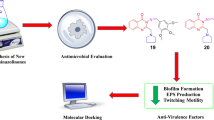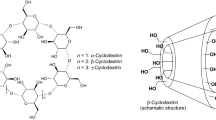Abstract
A novel organic cocrystal salt hydrate (CTPTH) of Chromotropic acid with 1,10-phenanthroline was successfully obtained using both traditional solution method and liquid-assisted grinding method, a green approach. The formation and characterization were done by Powder x-ray diffraction, Fourier-transform infrared spectroscopy, thermogravimetric analysis, and the structural confirmation by single crystal x-ray diffraction. The molecular properties were studied using density functional theory, B3LYP/def2-SVP including dispersion correction (D3) to calculate the HOMO and LUMO energies using Orca and Gaussian packages. The calculated geometric parameters were in good agreement with those of experimentally observed. The non-bonding interaction between the CTPTH and active site of the crystal structure of quorum-quenching N-Acyl homoserine lactone lactonase (PDB: 2BR6) in bacterium was studied by molecular docking. The total energy of ligand interaction of CTPTH with the receptor is found to be − 42.78 kcal mol−1. The Hirshfeld surfaces were mapped over dnorm for the identification and quantification of robust synthons for a better understanding of the overall packing pattern of CTPTH. In addition, the antibiofilm efficacy of CTPTH against the pathogenic bacterium Pseudomonas aeruginosa was also determined.












Similar content being viewed by others
References
Grant, S.S.; Hung, D.T.: Persistent bacterial infections, antibiotic tolerance, and the oxidative stress response. Virulence 4, 273–283 (2013). https://doi.org/10.4161/viru.23987
Hathroubi, S.; Mekni, M.A.; Domenico, P.; Nguyen, D.; Jacques, M.: Biofilms: microbial shelters against antibiotics. Microb. Drug Resist. 23, 147–156 (2017). https://doi.org/10.1089/mdr.2016.0087
Costerton, J.W.: Bacterial biofilms: a common cause of persistent infections. Science 284(80), 1318–1322 (1999). https://doi.org/10.1126/science.284.5418.1318
Vasudevan, R.: Biofilms: microbial cities of scientific significance. J. Microbiol. Exp. (2014). https://doi.org/10.15406/jmen.2014.01.00014
Khatoon, Z.; McTiernan, C.D.; Suuronen, E.J.; Mah, T.-F.; Alarcon, E.I.: Bacterial biofilm formation on implantable devices and approaches to its treatment and prevention. Heliyon 4, e01067 (2018). https://doi.org/10.1016/j.heliyon.2018.e01067
Desiraju, G.R.: Crystal engineering: from molecule to crystal. J. Am. Chem. Soc. 135, 9952–9967 (2013). https://doi.org/10.1021/ja403264c
Domingos, S.; André, V.; Quaresma, S.; Martins, I.C.B.; Minas da Piedade, M.F.; Duarte, M.T.: New forms of old drugs: improving without changing. J. Pharm. Pharmacol. 67, 830–846 (2015). https://doi.org/10.1111/jphp.12384
Shaikh, R.; Singh, R.; Walker, G.M.; Croker, D.M.: Pharmaceutical cocrystal drug products: an outlook on product development. Trends Pharmacol. Sci. 39, 1033–1048 (2018). https://doi.org/10.1016/j.tips.2018.10.006
Bond, A.D.: What is a co-crystal? CrystEngComm 9, 833 (2007). https://doi.org/10.1039/b708112j
Wong, S.N.; Hu, S.; Ng, W.W.; Xu, X.; Lai, K.L.; Lee, W.Y.T.; Chow, A.H.L.; Sun, C.C.; Chow, S.F.: Cocrystallization of curcumin with benzenediols and benzenetriols via rapid solvent removal. Cryst. Growth Des. 18, 5534–5546 (2018). https://doi.org/10.1021/acs.cgd.8b00849
Kumar Tewari, P.; Kumar Singh, A.: Amberlite XAD-2 functionalized with chromotropic acid: synthesis of a new polymer matrix and its applications in metal ion enrichment for their determination by flame atomic absorption spectrometry. Analyst 124, 1847–1851 (1999). https://doi.org/10.1039/a906479f
Duda, J.: Biological activity, reactivity, and use of chromotropic acid and its derivatives. Chem. Soc. Rev. 23, 425 (1994). https://doi.org/10.1039/cs9942300425
Clercq, E.De: New selective antiviral agents active against the AIDS virus. Trends Pharmacol. Sci. 8, 339–345 (1987). https://doi.org/10.1016/0165-6147(87)90143-X
Tan, G.T.; Wickramasinghe, A.; Verma, S.; Singh, R.; Pezzuto, J.M.; Mohan, P.; Wickramasinghe, A.; Singh, R.; Pezzuto, J.M.; Pezzuto, J.M.; Hughes, S.H.; Baba, M.: Potential anti-aids naphthalenesulfonic acid derivatives synthesis and inhibition of HIV-1 induced cytopathogenesis and HIV-1 and HIV-2 reverse transcriptase activities. J. Med. Chem. 35, 4846–4853 (1992). https://doi.org/10.1021/jm00104a010
Akerfeldt, S.; Westin, G.; Jansson, T.: Aromatic sulfonic acids as viral inhibitors. Structure-activity study using rhino, adeno 3, herpes simplex, and influenza viruses. J. Med. Chem. 14, 596–600 (1971). https://doi.org/10.1021/jm00289a010
Sharma, R.C.; Sharma, R.S.; Tripathi, S.P.: Biologically active mixed-ligand complexes of Cu(II), Ni(II) and Zn(II) and their effect on some bacteria and fungi. Curr. Sci. 52, 410–412 (1983)
Abidi, S.S.A.; Azim, Y.; Khan, S.N.; Khan, A.U.: Sulfaguanidine cocrystals: synthesis, structural characterization and their antibacterial and hemolytic analysis. J. Pharm. Biomed. Anal. 149, 351–357 (2018). https://doi.org/10.1016/j.jpba.2017.11.028
El Hamdani, H.; El Amane, M.; Duhayon, C.: Studies on the syntheses, structural characterization, antimicrobial of the CO-CRYSTAL 1,10-phenanthrolin-1-IUM(1,10-phenH +)-caffeine(caf)-hexafluorophosphate. J. Mol. Struct. 1155, 789–796 (2018). https://doi.org/10.1016/j.molstruc.2017.11.076
ACD/Percepta, version 2019.2.2, Advanced Chemistry Development, Inc., Toronto, ON, Canada, www.acdlabs.com. (2020)
Altomare, A.; Burla, M.C.; Camalli, M.; Cascarano, G.L.; Giacovazzo, C.; Guagliardi, A.; Moliterni, A.G.G.; Polidori, G.; Spagna, R.: SIR 97: a new tool for crystal structure determination and refinement. J. Appl. Crystallogr. 32, 115–119 (1999). https://doi.org/10.1107/S0021889898007717
Sheldrick, G.M.: A short history of SHELX. Acta Crystallogr. Sect. A: Found. Crystallogr. 64, 112–122 (2008). https://doi.org/10.1107/S0108767307043930
Dolomanov, O.V.; Bourhis, L.J.; Gildea, R.J.; Howard, J.A.K.; Puschmann, H.: OLEX2: a complete structure solution, refinement and analysis program. J. Appl. Crystallogr. 42, 339–341 (2009). https://doi.org/10.1107/S0021889808042726
Neese, F.: The ORCA program system. Wiley Interdiscip. Rev. Comput. Mol. Sci. 2, 73–78 (2012). https://doi.org/10.1002/wcms.81
Gaussian 09, Revision A.02, M. J. Frisch, G. W. Trucks, H. B. Schlegel, G. E. Scuseria, M. A. Robb, J. R. Cheeseman, G. Scalmani, V. Barone, G. A. Petersson, H. Nakatsuji, X. Li, M. Caricato, A. Marenich, J. Bloino, B. G. Janesko, R. Gomperts, B. Mennucci, H. P. Hratchian, J. V. Ortiz, A. F. Izmaylov, J. L. Sonnenberg, D. Williams-Young, F. Ding, F. Lipparini, F. Egidi, J. Goings, B. Peng, A. Petrone, T. Henderson, D. Ranasinghe, V. G. Zakrzewski, J. Gao, N. Rega, G. Zheng, W. Liang, M. Hada, M. Ehara, K. Toyota, R. Fukuda, J. Hasegawa, M. Ishida, T. Nakajima, Y. Honda, O. Kitao, H. Nakai, T. Vreven, K. Throssell, J. A. Montgomery, Jr., J. E. Peralta, F. Ogliaro, M. Bearpark, J. J. Heyd, E. Brothers, K. N. Kudin, V. N. Staroverov, T. Keith, R. Kobayashi, J. Normand, K. Raghavachari, A. Rendell, J. C. Burant, S. S. Iyengar, J. Tomasi, M. Cossi, J. M. Millam, M. Klene, C. Adamo, R. Cammi, J. W. Ochterski, R. L. Martin, K. Morokuma, O. Farkas, J. B. Foresman, and D. J. Fox, Gaussian, Inc., Wallingford CT, (2016)
Lee, C.; Yang, W.; Parr, R.G.: Development of the Colle-Salvetti correlation-energy formula into a functional of the electron density. Phys. Rev. B. 37, 785–789 (1988). https://doi.org/10.1103/PhysRevB.37.785
Tirado-Rives, J.; Jorgensen, W.L.: Performance of B3LYP density functional methods for a large set of organic molecules. J. Chem. Theory Comput. 4, 297–306 (2008). https://doi.org/10.1021/ct700248k
Weigend, F.; Ahlrichs, R.: Balanced basis sets of split valence, triple zeta valence and quadruple zeta valence quality for H to Rn: design and assessment of accuracy. Phys. Chem. Chem. Phys. 7, 3297 (2005). https://doi.org/10.1039/b508541a
Grimme, S.; Antony, J.; Ehrlich, S.; Krieg, H.: A consistent and accurate ab initio parametrization of density functional dispersion correction (DFT-D) for the 94 elements H-Pu. J. Chem. Phys. 132, 154104 (2010). https://doi.org/10.1063/1.3382344
Ahmad, F.; Alam, M.J.; Alam, M.; Azaz, S.; Parveen, M.; Park, S.; Ahmad, S.: Synthesis, spectroscopic, computational (DFT/B3LYP), AChE inhibition and antioxidant studies of imidazole derivative. J. Mol. Struct. 1151, 327–342 (2018). https://doi.org/10.1016/j.molstruc.2017.09.056
Alam, M.; Lee, D.-U.: Synthesis, spectroscopic and computational studies of 2-(thiophen-2-yl)-2,3-dihydro-1H-perimidine: an enzymes inhibition study. Comput. Biol. Chem. 64, 185–201 (2016). https://doi.org/10.1016/j.compbiolchem.2016.06.006
Schneidman-Duhovny, D.; Inbar, Y.; Nussinov, R.; Wolfson, H.J.: PatchDock and SymmDock: servers for rigid and symmetric docking. Nucleic Acids Res. 33, W363–W367 (2005). https://doi.org/10.1093/nar/gki481
Spackman, M.A.; Jayatilaka, D.: Hirshfeld surface analysis. CrystEngComm 11, 19–32 (2009). https://doi.org/10.1039/B818330A
O’Toole, G.A.; Kolter, R.: Initiation of biofilm formation in Pseudomonas fluorescens WCS365 proceeds via multiple, convergent signalling pathways: a genetic analysis. Mol. Microbiol. 28, 449–461 (1998). https://doi.org/10.1046/j.1365-2958.1998.00797.x
Ghanbarzadeh Corehtash, Z.; Khorshidi, A.; Firoozeh, F.; Akbari, H.; Mahmoudi Aznaveh, A.: Biofilm formation and virulence factors among pseudomonas aeruginosa isolated from burn patients. Jundishapur J. Microbiol. 8, 1 (2015). https://doi.org/10.5812/jjm.22345
Garg, U.; Azim, Y.; Kar, A.; Pradeep, C.P.: Cocrystals/salt of 1-naphthaleneacetic acid and utilizing Hirshfeld surface calculations for acid–aminopyrimidine synthons. CrystEngComm 22, 2978–2989 (2020). https://doi.org/10.1039/D0CE00106F
Velmurugan, G.; Angeline Vedha, S.; Venuvanalingam, P.: Computational evaluation of optoelectronic and photophysical properties of unsymmetrical distyrylbiphenyls. RSC Adv. 4, 53060–53071 (2014). https://doi.org/10.1039/C4RA07809H
Zhan, C.-G.; Nichols, J.A.; Dixon, D.A.: Ionization potential, electron affinity, electronegativity, hardness, and electron excitation energy: molecular properties from density functional theory orbital energies. J. Phys. Chem. A 107, 4184–4195 (2003). https://doi.org/10.1021/jp0225774
Thanikaivelan, P.; Subramanian, V.; Raghava Rao, J.; Unni Nair, B.: Application of quantum chemical descriptor in quantitative structure activity and structure property relationship. Chem. Phys. Lett. 323, 59–70 (2000). https://doi.org/10.1016/S0009-2614(00)00488-7
Al-Asbahy, W.M.; Usman, M.; Arjmand, F.; Shamsi, M.; Tabassum, S.: A dinuclear copper(II) complex with piperazine bridge ligand as a potential anticancer agent: DFT computation and biological evaluation. Inorganica Chim. Acta. 445, 167–178 (2016). https://doi.org/10.1016/j.ica.2016.02.046
Bayannavar, P.K.; Sannaikar, M.S.; Madan Kumar, S.; Inamdar, S.R.; Shaikh, S.K.J.; Nesaragi, A.R.; Kamble, R.R.: Synthesis, X-ray characterization, DFT studies and Hirshfeld surface analysis of new organic single crystal: 2-(4-Methoxyphenyl)-4-{[2’-(1H-tetrazol-5-yl)biphenyl-4-yl] methyl}-2,4-dihydro-3H-1,2,4-triazol-3-one (MTBT). J. Mol. Struct. 1179, 809–819 (2019). https://doi.org/10.1016/j.molstruc.2018.11.060
Suresh Kumar, S.; Athimoolam, S.; Sridhar, B.: Structural, spectral, theoretical and anticancer studies on new co-crystal of the drug 5-fluorouracil. J. Mol. Struct. 1173, 951–958 (2018). https://doi.org/10.1016/j.molstruc.2018.07.079
Acknowledgements
SSAA, UG, and YA are thankful to the Department of Applied Chemistry, A.M.U., for providing research facilities. UG is also thankful to CSIR-JRF for providing financial assistance.
Author information
Authors and Affiliations
Corresponding author
Electronic supplementary material
Below is the link to the electronic supplementary material.
Rights and permissions
About this article
Cite this article
Abidi, S.S.A., Garg, U., Azim, Y. et al. Spectroscopic, Structural, DFT and Molecular Docking Studies on Novel Cocrystal Salt Hydrate of Chromotropic Acid and Its Antibiofilm Activity. Arab J Sci Eng 46, 353–364 (2021). https://doi.org/10.1007/s13369-020-04822-x
Received:
Accepted:
Published:
Issue Date:
DOI: https://doi.org/10.1007/s13369-020-04822-x




